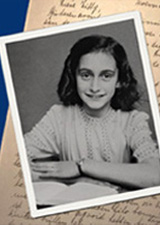About the Program
Annelies
January 21 & 28, 2024
Annelies Marie Frank was born in Frankfurt am Main, Germany, in June 1929. In 1934, she moved with her family from Germany to the Netherlands. A stagnant post-Depression economy and the growing power of the Nazis under Adolf Hitler motivated Otto and Edith, Anne’s parents, to leave their life in Frankfurt behind and settle in Amsterdam, where Otto established Opekta, a factory which produced pectin for jellies and jams. As Hitler and the Third Reich consolidated power, they enacted a series of laws restricting the lives of Jews. Concerned with the reports of open aggression against German Jews and the increase of antisemitic rhetoric in public discourse, Otto had attempted to move his family to Great Britain, but did not succeed.
Around the time of the Kristallnacht (November 1938), Otto placed his family on a waiting list for an American immigration visa, joining a queue of over 200,000 European Jews who hoped to escape to safety in the U.S. In May 1940, Germany invaded and occupied the Netherlands, seeking military advantage for an eventual invasion of France. The Franks began making plans to go into hiding, installing a bookcase on hinges that would hide a set of stairs to a “secret annex” behind and above the Opekta shop. Aided by three factory workers, the Franks furnished their annex and built a stock of supplies for their time in hiding. They would be joined by four Dutch Jews — the van Pels family (Hermann, Auguste, and their teenaged son, Peter) and Fritz Pfeffer, a friend of the Franks.
When, on July 5, 1942, Anne’s elder sister, Margot, received a notice from the Nazi government to report to a German Labor Camp, their plans were moved up by several weeks. The eight went into hiding in the secret annex.
A short while earlier, on her thirteenth birthday, Anne had received a diary as a gift. Over the next 761 days, she wrote of her experiences while in hiding. After the annex residents were captured (August 4, 1944), this extraordinary diary was rescued by Miep Gies, a factory worker who aided the annex residents, and eventually published by Otto Frank, the only resident to survive the Holocaust. It has subsequently become one of the most read literary works of the 20th century, having sold more than 30 million copies and been translated into more than 70 languages.
The world premiere of Annelies was given on April 5, 2005 at Cadogan Hall, London. The U.S. premiere of Annelies was given on April 28, 2007 at Westminster Choir College, Princeton, NJ. James Jordan and James Whitbourn conducted the Westminster Williamson Voices, an instrumental ensemble and soprano Lynn Eustis. The world premiere of Annelies in its completed chamber version was given on June 12, 2009 in the German Church, The Hague, the Netherlands. I am proud to have conducted the high school premiere of the complete work in April 2016 at Lexington High School with soprano Lynn Eustis.
James Whitbourn, composer, shared some insight about the work:
“...at the time of writing the diary, Anne had not experienced the Holocaust first hand, though she was much more aware of it than her companions-in-hiding realized…Anne knew what was happening. But none of the housemates, not even her own parents, realized the depths of her understanding.
….
It is these penetrating observations that form the basis of Melanie Challengerʼs libretto…From the outset, we were clear that it was those remarkable observations that were to form the basis of this work. Squabbles within the annex, teenage romantic encounters and the like were all put aside, and the diary distilled into this sequence of beautiful, spiritually-charged texts.
….
Rarely have I found a text so compelling and the inspiration for so much thought. But…as I worked on the score, I became more aware of Anne Frank as a contemporary person. Eventually, I came to meet Bernd…her cousin, and later one of her school friends, of whom she speaks so often in the diary. These personal family links influenced the kind of piece it was destined to be, and at times it felt as though I were putting together the music for the familyʼs memorial event. It was to be a commemorative work, not only for Anne Frank, but for those by whose side she lived, those she watched with penetrating eyes, and those voiceless millions who shared her fate.”
At the time of the Holocaust, Germany was an advanced democracy with a well-educated population. Post-World War I über-nationalism and economic strain were exploited by an authoritarian leader who built political success on propaganda about European Jews. Millions were annihilated out of fealty to these lies and those voicing them.
Unfortunately, our present era is characterized by too many corollary antecedents of that time and place. It is not the duty of Jewish people, but of all people, to find ways to memorialize the terrible events of the Holocaust, working to assure that we never forget not only the human cost, but also the somnolent banality with which an entire society descended into darkness. With the rise of overt antisemitic language and actions in our country, I feel this piece is particularly important at this moment. Social media is a wondrous tool for communication, but it may also be misused to amplify the hateful voices of anti-Semites and Holocaust deniers. In presenting this moving and thoughtful portrait of the young Anne, whose writing reveals maturity beyond her years, Cantemus Chamber Chorus hopes that we might counteract these hateful voices by raising our own.
—Jason Iannuzzi, Artistic Director


 Click to view poster [pdf]
Click to view poster [pdf]